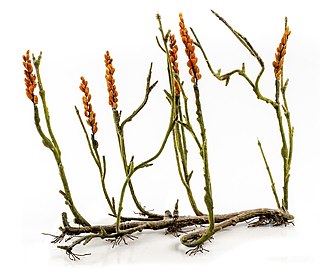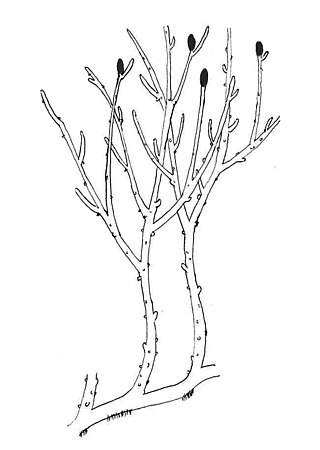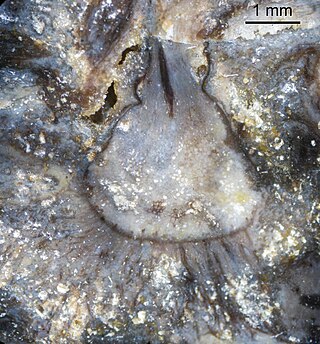
The lycophytes, when broadly circumscribed, are a group of vascular plants that include the clubmosses. They are sometimes placed in a division Lycopodiophyta or Lycophyta or in a subdivision Lycopodiophytina. They are one of the oldest lineages of extant (living) vascular plants; the group contains extinct plants that have been dated from the Silurian. Lycophytes were some of the dominating plant species of the Carboniferous period, and included the tree-like Lepidodendrales, some of which grew over 40 metres (130 ft) in height, although extant lycophytes are relatively small plants.

Psilotum is a genus of fern-like vascular plants. It is one of two genera in the family Psilotaceae commonly known as whisk ferns, the other being Tmesipteris. Plants in these two genera were once thought to be descended from the earliest surviving vascular plants, but more recent phylogenies place them as basal ferns, as a sister group to Ophioglossales. They lack true roots and leaves are very reduced, the stems being the organs containing photosynthetic and conducting tissue. There are only two species in Psilotum and a hybrid between the two. They differ from those in Tmesipteris in having stems with many branches and a synangium with three lobes rather than two.

The Rhynie chert is a Lower Devonian sedimentary deposit exhibiting extraordinary fossil detail or completeness. It is exposed near the village of Rhynie, Aberdeenshire, Scotland; a second unit, the Windyfield chert, is located some 700 m away. The Rhynie chert contains exceptionally preserved plant, fungus, lichen and animal material preserved in place by an overlying volcanic deposit. The bulk of the Devonian fossil bed consists of primitive plants, along with arthropods, lichens, algae and fungi.

The zosterophylls are a group of extinct land plants that first appeared in the Silurian period. The taxon was first established by Banks in 1968 as the subdivision Zosterophyllophytina; they have since also been treated as the division Zosterophyllophyta or Zosterophyta and the class or plesion Zosterophyllopsida or Zosteropsida. They were among the first vascular plants in the fossil record, and had a world-wide distribution. They were probably stem-group lycophytes, forming a sister group to the ancestors of the living lycophytes. By the late Silurian a diverse assemblage of species existed, examples of which have been found fossilised in what is now Bathurst Island in Arctic Canada.

Asteroxylon is an extinct genus of vascular plants of the Division Lycopodiophyta known from anatomically preserved specimens described from the famous Early Devonian Rhynie chert and Windyfield chert in Aberdeenshire, Scotland. Asteroxylon is considered a basal member of the Lycopsida.

Drepanophycales is an order of extinct lycophyte plants of Late Silurian to Late Devonian age, found in North America, China, Russia, Europe, and Australia. Sometimes known as the Asteroxylales or Baragwanathiales.

The rhyniophytes are a group of extinct early vascular plants that are considered to be similar to the genus Rhynia, found in the Early Devonian. Sources vary in the name and rank used for this group, some treating it as the class Rhyniopsida, others as the subdivision Rhyniophytina or the division Rhyniophyta. The first definition of the group, under the name Rhyniophytina, was by Banks, since when there have been many redefinitions, including by Banks himself. "As a result, the Rhyniophytina have slowly dissolved into a heterogeneous collection of plants ... the group contains only one species on which all authors agree: the type species Rhynia gwynne-vaughanii". When defined very broadly, the group consists of plants with dichotomously branched, naked aerial axes ("stems") with terminal spore-bearing structures (sporangia). The rhyniophytes are considered to be stem group tracheophytes.

Polysporangiophytes, also called polysporangiates or formally Polysporangiophyta, are plants in which the spore-bearing generation (sporophyte) has branching stems (axes) that bear sporangia. The name literally means 'many sporangia plant'. The clade includes all land plants (embryophytes) except for the bryophytes whose sporophytes are normally unbranched, even if a few exceptional cases occur. While the definition is independent of the presence of vascular tissue, all living polysporangiophytes also have vascular tissue, i.e., are vascular plants or tracheophytes. Extinct polysporangiophytes are known that have no vascular tissue and so are not tracheophytes.

Aglaophyton major was the sporophyte generation of a diplohaplontic, pre-vascular, axial, free-sporing land plant of the Lower Devonian. It had anatomical features intermediate between those of the bryophytes and vascular plants or tracheophytes.

Rhynia is a single-species genus of Devonian vascular plants. Rhynia gwynne-vaughanii was the sporophyte generation of a vascular, axial, free-sporing diplohaplontic embryophytic land plant of the Early Devonian that had anatomical features more advanced than those of the bryophytes. Rhynia gwynne-vaughanii was a member of a sister group to all other eutracheophytes, including modern vascular plants.

Horneophyton is an extinct early plant which may form a "missing link" between the hornworts and the Rhyniopsida. It is a member of the class Horneophytopsida. Horneophyton is among the most abundant fossil organisms found in the Rhynie chert, a Devonian Lagerstätte in Aberdeenshire, UK. A single species, Horneophyton lignieri, is known. Its probable female gametophyte is the form taxon Langiophyton mackiei.
Psilophytopsida is a now obsolete class containing one order, Psilophytales, which was previously used to classify a number of extinct plants which are now placed elsewhere. The class was established in 1917, under the name Psilophyta, with only three genera for a group of fossil plants from the Upper Silurian and Devonian periods which lack true roots and leaves, but have a vascular system within a branching cylindrical stem. The living Psilotaceae, the whisk-ferns, were sometimes added to the class, which was then usually called Psilopsida. This classification is no longer in use.
Hicklingia is a genus of extinct plants of the Middle Devonian. Compressed specimens were first described in 1923 from the Old Red Sandstone of Scotland. Initially the genus was placed in the "rhyniophytes", but this group is defined as having terminal sporangia, and later work showed that the sporangia of Hicklingia were lateral rather than strictly terminal, so that it is now regarded as having affinities with the zosterophylls.
Huia is a genus of extinct vascular plants of the Early Devonian. The genus was first described in 1985 based on fossil specimens from the Posongchong Formation, Wenshan district, Yunnan, China.
Discalis is a genus of extinct vascular plants of the Early Devonian. The name is derived from the Greek δίσκος, referring to the disc-shaped sporangia. The genus was first described by Hao in 1989 based on fossil specimens from the Posongchong Formation, Wenshan district, Yunnan, China.
Dutoitia is a genus of Devonian rhyniophyte, named after the renowned South African geologist Alex du Toit. It is one of the earliest plants from Gondwana to colonize land. Its fossils were preserved in fine mudstones of the 400-million-year-old Bokkeveld and Witteberg Groups of South Africa. This erect, gracile plant is less than 10 cm high and very simple in structure. Its diminutive stems, which are devoid of leaflike appendages, branch in two and end in club- or cup-shaped sporangia, occasionally containing its reproductive spores. Stomata are present in the cuticle of their stems for gas exchange, and primitive cells inside the stems transported water from the roots to the aerial parts of the plant. Three species are recognized, D. pulchra Hoeg 1930, D. alfreda Plumstead 1967 and D. maraisia Plumstead 1967.

Ventarura is a genus of extinct vascular plants of the Early Devonian. Fossils were found in the Windyfield chert, Rhynie, Scotland. Some features, such as bivalved sporangia borne laterally and the anatomy of the xylem, relate this genus to the zosterophylls. Other features are unclear due to poor preservation.
Trichopherophyton is a genus of extinct vascular plants of the Early Devonian. Fossils were found in the Rhynie chert, Scotland. The remains are very fragmentary, but the plant appears to be related to the zosterophylls.
Wenshania is a genus of extinct vascular plants found in the Posongchong Formation, Yunnan, China, which is of Early Devonian age. Plants consisted of leafless stems with simple dichotomous branching, and bore spore-forming organs or sporangia all around the sides of stems. Wenshania is part of the broadly defined group of zosterophylls.

Macivera is a genus of extinct vascular plants. Fossils were found in sediments in Bathust Island, Nunavut, Canada, from the upper Silurian. The leafless stems (axes) branched dichotomously and were relatively thin, being between 0.7 and 1.0 mm wide. Spore-forming organs or sporangia, which were elliptical, being longer than wide, were borne on the end regions of stems. Macivera is considered to be a zosterophyll.













